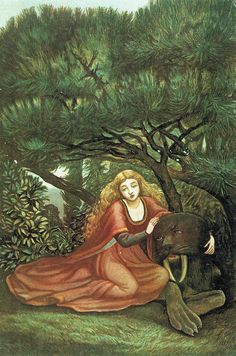Eleanor Vere Boyle facts for kids
Quick facts for kids
Eleanor Vere Boyle
|
|
|---|---|
| Born | 1 May 1825 Auchlunies, Aberdeenshire, Scotland |
| Died | 29 July 1916 (aged 91) Brighton, East Sussex, England |
| Occupation | Illustrator, Writer |
| Nationality | English |
| Period | 19th century |
| Genre | Children's Literature |
Eleanor Vere Boyle (1825–1916) was a talented artist from the Victorian era. She was best known for her beautiful watercolor pictures in children's books. Her art was inspired by the Pre-Raphaelites, a group of artists who loved detailed and sometimes mysterious themes. They often explored ideas of love and death, which you can also see in Eleanor's work.
Even Dante Gabriel Rossetti, a famous artist and founder of the Pre-Raphaelite Brotherhood, praised her designs. Eleanor was one of the first women artists to be recognized for her skills. However, because of her family's high social status, she didn't often show or sell her art. To keep her identity a secret, she signed her works "EVB." She quickly became one of the most important female illustrators in the 1860s.
About Eleanor Vere Boyle

Eleanor Vere Boyle was born in Scotland on May 1, 1825. She grew up as the youngest of eight children in the Scottish hills near the River Dee. Her father was Alexander Gordon of Ellon Castle.
Later, she moved to England and married Richard Boyle. He was the son of the Earl of Cork and served as a chaplain to Queen Victoria.
Eleanor Vere Boyle loved nature very much. This love greatly influenced her artwork. After her husband passed away, she mainly created books about gardens. But during her life, until she died in 1916, she was famous for her work in children's books. Eleanor wrote or illustrated 21 books over about 50 years. Her works were inspired by nature, but also by dreams, fate, and flowing water.
Her Main Artworks
Eleanor's love for nature and other themes was clear in her illustrations. She created pictures for the poet Tennyson's May Queen in 1852. Her unique style was even more obvious in her illustrations for Hans Christian Andersen’s fairy tales in 1872. This was one of the first times an English artist illustrated Andersen's stories.
Her edition included 12 full-color pictures and many other drawings. Many of Andersen's stories have a dark side. Eleanor was great at showing this in her art with her own slightly mysterious touch. This made her edition one of the best matches between pictures and writing. It set a new standard for how Hans Andersen's work would be illustrated in the future. Some of her most famous illustrations from this book include "The Snow Queen" and "The Little Mermaid."
Three years later, in 1875, Eleanor Vere Boyle created one of her most famous works. She retold and illustrated the well-known story Beauty and the Beast. This book has 10 full-color pictures. People especially praise her unique way of drawing the Beast. Many artists have illustrated this story. But Eleanor's Beast looks like a sea-creature with walrus-like tusks and flippers. This was very different from the usual human-like Beast. She moved away from the normal look, showing the Beast without an upright position, human face, or clothes.
Other important works by Eleanor Vere Boyle include her pictures in The Story Without an End and Child’s Play. She also wrote and illustrated Ros Rasarum Ex Horto Poetarum (1885). The Story Without an End was originally a German story. It was translated into English and illustrated by Eleanor.
Child’s Play and Ros Rasarum Ex Horto Poetarum were books Eleanor created herself. In Child’s Play, she matched famous nursery rhymes with her illustrations. In Ros Rasarum Ex Horto Poetarum, Eleanor wrote poems and drew pictures to go with them. The title means "Dew of the Ever-living Rose, Gathered from the Poets' Gardens of Many Lands." Scholars highly praise this book and say it is culturally important. It is kept as a historic item and is available for everyone to read here.
Eleanor Vere Boyle continued writing even after Ros Rasarum Ex Horto Poetarum. Near the end of her career, she focused on nature. She wrote and illustrated garden books. In the last 32 years of her life, she created four such books:
- Days and Hours in a Garden (1884)
- A Garden of Pleasure (1895)
- Seven Gardens and a Palace (1900)
- Garden Colour (1905)
Her last work was The Peacocks Pleasaunce (1908), released eight years before she died. This book was a collection of 12 beautiful writings, also known as belles-lettres, with eight illustrations.
Other Works
- A Child's Summer (1853)
- In the Fir-Wood (1866)
- A New Child's Play (1877)
- A London Sparrow at the Colinderies (1887)
- A Midsummer-Night Dream (1887)
- Sylvana's Letters to an Unknown Friend (1900)
See also
 In Spanish: Eleanor Vere Boyle para niños
In Spanish: Eleanor Vere Boyle para niños

